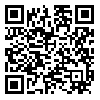1. Aminoroaia M, Attari A, Maracy M. Factor's affecting medical students' tendency to smoke cigarettes. Jornal of Research Behavior Sciences. 2013; 10 (7): 726-734. [Persian]
2. WHO report on the global tobacco epidemic, 2011. Warning about the dangers of tobacco. Geneva: World Health Organization; 2011.
3. Momoh So, Imhond Ho, Omagbe.E. The role of gender, self- studi-efficacy, age and extroversion on smoking behaviour among Ambrose Alli University Students, Ekpoma, Nigeria. Journal of International Women's Studies.2008; 10(2): 134-140.
4. Wong CJ, Anthony S, Sigmon SC, et al. Examining interrelationships between abstinence and coping self-efficacy in cocaine-dependent outpatients. Experimental and Clinical Psychopharmacology. 2004; 21(3): 190- 199. [
DOI:10.1037/1064-1297.12.3.190]
5. Mohamdkhani Sh, Jazayeri A, Mohamdkhani P, et al. Direct and indirect impact of attitude, locus of control, selfmanagement skills and so commences on drug use among at risk adolescents. Contemporary Psychology. 2004; 2(3):3-10. [Persian]
6. Copeland AL, Brandon TH. Testing the causal role of expectancies in smoking motivation and behavior. Journal of Addictive Behaviors. 2000; 25(3): 445-449. [
DOI:10.1016/S0306-4603(99)00003-9]
7. Noranipour R. Investigate the causes of addiction to substances changing the mood and behavior and effective and efficient method of drug addiction counseling. Journal of Research on Adiction. 2004; 2(6): 13- 54. [Persian]
8. Boardman T, Catley D, Mayo MS, et al. Self-efficacy and motivation to quit during participation in a smoking cessation program. International Journal of Behavioral Medicine. 2005; 12(4): 266-272. [
DOI:10.1207/s15327558ijbm1204_7]
9. Chang FC, Lee CM, Lai HR, et al. Social influences and self-efficacy as predictors of youth smoking initiation and cessation: a 3-year longitudinal study of vocational high school students in Taiwan. Addiction. 2006; 101(11): 1645-1655. [
DOI:10.1111/j.1360-0443.2006.01607.x]
10. Zhang D, He H. Personality traits and life satisfaction: A Chinese case study. Social Behavior and Personality: An International Journal. 2010; 38(8): 1119-1123. [
DOI:10.2224/sbp.2010.38.8.1119]
11. Young JE. Young schema questionnaire: short form 3 (YSQ-S3). New York: Schema Therapy Institute; 2005. [
DOI:10.1037/t67023-000]
12. DeBono A, Muraven M. Rejection perceptions: feeling disrespected lead to greateraggression than feeling disliked.Journal of Experimental Social Psychology. 2014; 55: 43-52. [
DOI:10.1016/j.jesp.2014.05.014]
13. Young JE, Kolsko JS, Wisshar ME. Shema therapy: A praticitionerers guide. New York: Guilford Press; 2003.
14. Yang J, McCrae RR, Costa Jr PT, et al. Cross-cultural personality assessment in psychiatric populations: The NEOPI-R in the people's Republic of China. Psychological Assessment. 1999; 11(3): 359-368. [
DOI:10.1037/1040-3590.11.3.359]
15. Shorey RC, Anderson SE, Stuart GL. Gender differences in early maladaptive schemas in a treatment-seeking sample of alcohol-dependent adults. Substance Use & Misuse. 2012; 47(1): 108-116. [
DOI:10.3109/10826084.2011.629706]
16. Shorey RC, Stuart GL, Anderson S, et al. Changes in early maladaptive schemas after residential treatment for substance use. Journal of Clinical Psychology. 2013; 69(9): 912- 922. [
DOI:10.1002/jclp.21968]
17. Young JE. Young schema questionnaire short Form. 1st ed. New York: Cognitive Therapy Center; 1998. [
DOI:10.1037/t12644-000]
18. Baranoff J, Oei TP, Cho SH, et al. Factor structure and internal consistency of the Young Schema Questionnaire (Short Form) in Korean and Australian samples. Journal of Affective Disorders. 2006; 93(1-3): 133-140. [
DOI:10.1016/j.jad.2006.03.003]
19. Ebrahimi H, Khamesan A, Pakdaman M. Construction and validation of smoking abstinence self - efficacy scale.Applied Psychological Research Quarterly. 2014; 5(3): 95- 110.
20. Riso LP, Du Toit PL, Stein DJ, et al. Cognitive schemas and core beliefs in psychological problems: A scientistpractitioner guide. Washington, DC, US: American Psychological Association; 2007. [
DOI:10.1037/11561-000]
21. Johnson MP, Leone JM. The differential effects of intimate terrorism and situational couple's violence: findings from the national violence against women survey. Journal of Family Issues. 2005; 26(3): 322- 349. [
DOI:10.1177/0192513X04270345]
22. Osrowsky MK. Are violent people more likely to have low self-esteem or high self-esteem?. Aggression and Violent Behavior. 2010; 15(1): 69-75. [
DOI:10.1016/j.avb.2009.08.004]








